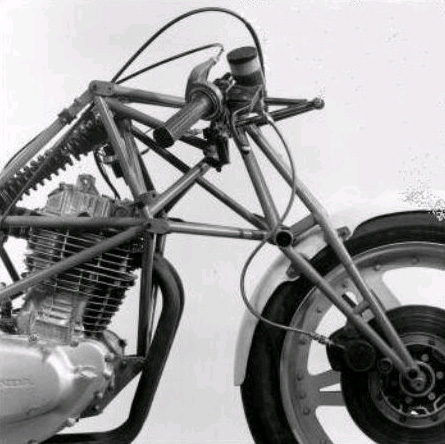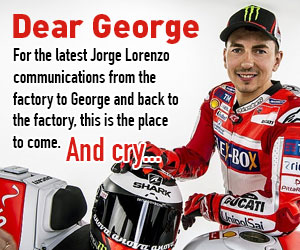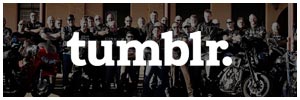HISTORY OF THE FRONT END – PART V
THE HOSSACK FRONT END

The original Hossack
Norman Hossack built a BSA Bantam out of bits when he was a twelve year old schoolboy in Rhodesia.
He bought a Greeves trail bike, raced a Ducati 250, and at the age of 23 moved to the UK where he saw his first Isle of Man TT.
He raced a little in Europe, worked as a mechanic for other racers, and started inventing things. He designed and built a two-stroke engine with a combined piston crown and connecting rod, and it worked.
He joined Bruce McLaren Racing and worked on building race car chassis, pit crewing and field engineering. And one day, while looking at a Formula 1 racing car suspension, he thought he could turn it ninety degreees and put it on the front of a motorcycle.
The McLaren M23 had a front wheel weight of approximately 115Kg per wheel. The triangulated structure that held it weighed less than 2Kg. The front end of a motorcycle has similar weight loads, but the suspension weighs much more than 2Kg.

A Cosentino with a Hossack front end showing the twin wishbones
He made a model from bits of coathanger wire, and it seemed like it would work. So he built a frame. A mate bought him an engine, and he made it fit.
The Hossack I was a Honda XL500 engine in a home grown frame, and it raced, and it won. Hossack II was a Rotax 250 in a Hossack frame. It raced, and it won too.
Norman Hossack’s frames were triangulated and very rigid. His bikes handled extraordinarily well.
His design was very special. Two triangular wishbones pivoted on the frame. Each had a rose joint at its apex, and the fork (or “upright” as Norman called it) was attached to these rose joints. A system of linkages, also containing rose joints, connected the handlebars to the fork.
The rake, trail and wheelbase remained pretty well constant while the suspension cycled.
No-one in racing was very interested. Norman built a few more race bikes, and coverted a few street machines for owners who had seen the Hossack front end and appreciated it.
In the early ’80s, Norman got an opportunity to tender for a contract to supply motorcycles to the British army. The motorcycle he came up with was pretty amazing. The prototype had front and back wheels that were quick-change and interchangeable. You could change the inner tube without removing the wheel. The front fork leg was pressurized, and could inflate the tyre after you’d repaired it.
No-one in the Ministry of Defence was very interested, and Norman went broke. He built a few conversions of street bikes – the last one in 1994. His patents lapsed.
In 2004, BMW released the K1200S. It had a new front suspension, which BMW called the Duolever. It wasn’t that new. It was a Hossack front end.

The BMW Duolever
Norman, of course, had mixed feelings about this. He didn’t get the glory or the cash, but he did see his design vindicated. On his web site are copies of three “essays” he published on a BMW fan site after the release of the K1200S.
In one, he says:
So here are my parental offerings.
- You will be decelerating much faster than you think while braking. Most riders judge how hard they are stopping by the quantity of dive they are experiencing. Riders are familiar with this visual cue and ‘know it’ without knowing it. This machine will not dive the same way but will stop faster as the wheel rides freely over the road.
- The best, lightest, free-est, suspension system can do little to change the limit of tire adhesion. The best, lightest, free-estst, suspension system is doing its job by telling you, loud and clear, where that limit is.
- Talk of low c/g and 50/50 weight distribution and long wheelbase may scare some people. These are the right numbers for this type of system and exactly the way I would have done it, if I had had the influence needed. High c/g and steep head angles are popular only because they mask the weaknesses inherent in ‘teles’.
Enjoy.
His succinct explanation of why he thinks his front end is the best on the market is worth reproducing, too:
To look at the fundamentals of my design there are some first principal elements to study.
- Lower weight. A bar bending between fulcrums suffers a pure bending load. However if the load wasn’t strictly bending, but straight push and pull, it could carry a load thousands of times higher. This higher value can be exploited with triangulation. Race car wishbones are an excellent example. These little devices can carry thousands of times their own weight and have near total rigidity. Everything on my design is triangulated and with that added strength you have a chance to save weight.
- If you were able to look down the axis of the steering on my design you would see that the weight was quite close to the pivot axis. This means low polar moment and this is important because most forms of weave are sustained by this mass. The further it is from the axis the greater the chance it can add to weave.
- Low stiction allows the tyre to ride bumps in with out being bullied by the suspension this is where grip come from. You will commonly hear commentators say ‘mechanical grip’ in F1 events and that’s what I am talking about here.
- Tellies (telescopic forks) turn brake loads into dive, and dive limits free wheel movement. My system doesn’t do that and allows full and free movement even while braking. But more when a tyre is stopped too hard and it loses traction, the energy stored in the front spring of a telescopic system is suddenly released and it punches the tyre further making the chance of regaining traction nearly impossible. Vernon Glasier on HOSSACK 1, my first bike, could readily slide the front wheel and still regain traction.

A Hossack Suzuki 125
BMW have recently announced a return to racing. We don’t yet know whether their superbike racers will have Hossack/Duolever suspension. If they do, will the advantages which Norman lists translate into lower lap times? And will riders who have cut their teeth on telescopic forks be able to adapt to suspension which behaves so differently?
2009 promises to be an interesting year in World Superbike racing.

Hossack3 – a Yamaha RD350










